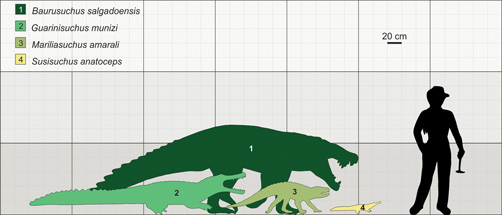Susisuchus anatoceps – Probably a Dwarf Crocodile
A team of Brazilian based scientists have concluded that the Early Cretaceous crocodile Susisuchus (Susisuchus anatoceps) may not have been as large as previously thought. Writing in the on-line, open access journal PLOS One, the researchers suggest that this species may have grown to less than one metre in length. It had been thought that specimens collected to date represented juveniles but analysis of growth rings preserved in the fossilised bones of one individual, believed to have died when it was around seventeen years old, suggests that this reptile rarely exceeded seventy centimetres in length.
Crocodile Subjected to Shrink Ray (Susisuchus anatoceps)
Early Cretaceous Crocodile Subjected to Palaeontologist Shrink Ray
Picture credit: University of Queensland with additional annotation by Everything Dinosaur
Originally described in 2003 from a partial skeleton representing an individual whose desiccated carcase probably laid out on an ancient riverbed for some considerable time before eventual burial, Susisuchus anatoceps is known from about ten fossil specimens, which from their small size were all thought to represent young animals.
Studying Growth Rings Preserved in the Fossil Bones
However, the scientists, which included lead author of the scientific paper Juliana M. Sayão from the Universidade Federal de Pernambuco (north-eastern Brazil), analysed the internal structures of a two bones (a rib and a bone from the lower front limb – an ulna) from a Susisuchus and concluded that this specimen represented an animal that was a sub-adult and therefore nearly fully grown. This research suggests that these crocodiles were small bodied and comparable to extant dwarf crocodiles.
The Fossil Specimen Studied Showing Location Where Bone Samples Were Taken and Close up Views of the Bone Structure

A close up of the rib and limb bone fragment used to assess the age of a Susisuchus anatoceps crocodile specimen.
Picture credit: PLOS One
The picture above shows (A) the fossil specimen of Susisuchus (MPSC R1136), which is part of the vertebrate fossil collection of the Museu de Paleontologia da Universidade Regional do Cariri (Santana do Cariri, Ceará State, Brazil). The scale bar for (A) is five centimetres. The area in red (marked B) and green (marked C) with arrows (corresponding to rib and ulna respectively) indicate where the cuts were made for the bone sample collection. (B) View of the cross section of the ulna. (C) View of the cross section of the rib. In the scientific journal the scale bar for B and C is reported as being 5 mm but we suspect that this scale is inaccurate for both photographs.
For models and replicas of ancient crocodilians: Mojo Fun Prehistoric and Extinct Figures.
Susisuchus anatoceps
Fossils of this ancient crocodile come from the Crato Formation of Brazil and indicate that Susisuchus lived around 112 to 100 million years ago. Similar crocodile fossils have been discovered in Australia suggesting that these types of crocodiles may have migrated using river systems that linked these parts of the super-continent Gondwana. Although, now known to be small, when it comes to crocodylomorphs Susisuchus punches way above its weight as it is one of the oldest crocodilians with a dermal skeleton very similar to that seen in extent crocodilians (members of the Eusuchia), comprising a dorsal shield comprising of at least six longitudinal rows of osteoderms (dermal armour).
This suggests that Susisuchus is phylogenetically very close to the origin of Eusuchia. It was distantly related to modern day crocodiles, caiman, alligators and gharials.
Susisuchus anatoceps – On the Road to Modern Crocodylians
Picture credit: University of Queensland
Crato Formation Crocodilians
Despite the wealth of vertebrate fossil material associated with the Crato Formation, crocodile fossils are relatively rare. Many palaeontologists believe that the Crato Formation deposits, the majority of which represent a brackish, lagoonal type environment was not the natural habitat of Susisuchus, instead the bodies of animals were washed downstream into the lagoon and therefore the carcase may have travelled extensively before final deposition. It is probable that Susisuchus lived in freshwater environments further inland and it fed on small fish, molluscs and amphibians.
Comparing the Size of Brazilian Cretaceous and Early Palaeocene Crocodiles

Comparative size of Susisuchus anatoceps to other Brazilian Cretaceous and Palaeocene Crocodylomorphs.
Picture credit: PLOS One
The diagram above shows Susisuchus anatoceps (4) compared to three other Brazilian crocodylomorphs from the Cretaceous and Early Palaeocene namely:
1). Baurusuchus salgadoensis a 4.5 metre long terrestrial predator named in 2005 known from the Adamantina Formation of Brazil which lived around 90-83 million years ago.
2). Guarinisuchus munizi a 3 metre long marine crocodile known from the Early Palaeocene.
3). Mariliasuchus amarali a one metre long, highly terrestrial crocodile known from the upper part of the Adamantina Formation indicating a Late Cretaceous age (possibly Campanian or perhaps Maastrichtian faunal stage).
Visit Everything Dinosaur’s website: Everything Dinosaur.








[…] Was a crocodilian ancestor from the Cretaceous of Brazil subject to an evolutionary shrink ray? (Link) Speaking of crocodilians, our own Jon Tennant gives an in-depth post about the history of the […]